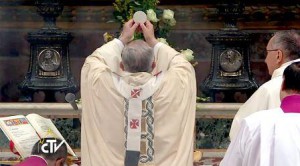 I had the pleasure of reading column by Bp. Thomas Tobin of Providence, Rhode Island. HERE
I had the pleasure of reading column by Bp. Thomas Tobin of Providence, Rhode Island. HERE
Keeping our Eyes on the Prize: Jesus
Let us keep our eyes fixed on
Jesus, the leader and perfecter of our faith. (Heb 12:2)
[…]
And St. John Paul offered this affirmation: “The Eucharist is a priceless treasure: by not only celebrating it, but also by praying before it outside of Mass, we are enabled to make contact with the wellspring of grace.”
In short, praying before the Blessed Sacrament is an excellent way of nourishing our friendship with Christ.
That shouldn’t be surprising, though, for it’s only natural to look at the one to whom we’re speaking, isn’t it? It’s that same instinct, I think, that’s leading to a renewed appreciation of the celebration of the Mass ad orientem, that is, priest and people facing the Lord, instead of one another. Keep in mind, it is an approved liturgical option.
Cardinal Robert Sarah, the Prefect of the Congregation for Divine Worship and the Sacraments, and champion of ad orientem worship, in a recent interview explained the need for “conversion,” a turning-around, this way: “The best way to celebrate, for priests and faithful, is turned together in the same direction – toward the Lord who comes. It’s to turn together toward the apse, which symbolizes the East, where the cross of the risen Lord is enthroned. By this manner of celebrating, we experience even in our bodies, the primacy of God and adoration.”
The orientation of the priest while celebrating Holy Mass is a fruitful discussion, one that we might explore at some point in the future.
But far more important than our physical posture is the openness of our minds and hearts; to remember that our prayer is the foundation of our faith and the key to spiritual growth. It is in prayer, after all, that we “keep our eyes fixed on Jesus.”
Fr. Z kudos to Bp. Tobin.



































Ad orientum worship requires that the tabernacle be present so the priest and worshippers can face it, correct? We have a cross with the risen Lord behind the altar, but the tabernacle is in the adoration chapel at the back of the sanctuary.
I pray that Mass is worshiped Ad Orientum…….everyone faces Jesus. I need to keep my eyes closed most of the time so as not to be distracted by what’s going on, on the altar. I want to open my eyes and adore my King.
@bib1003:
Oh my, no, the tabernacle does not need to be on the altar where ad orientem worship is used. In fact, the rubrics assume that it usually is not:
“When the priest reaches the altar… he hands the biretta to the server, and bows profoundly to the altar or the crucifix upon it. But, if the tabernacle with the Blessed Sacrament is on this altar, he genuflects…”
In the case that the tabernacle is not on the altar where Mass is being said ad orientem, the priest is still leading the congregation in prayer facing towards Our Lord in the image of the crucifix.
Thanks mschu528!
The wrong Tobin got the red hat ;-)
Seriously, when a “conservative” bishop like (Thomas) Tobin feels free to express himself in favor of ad orientem worship that is a very good sign. Perhaps a few positive letters from his flock will encourage him to implement it in his own cathedral.
Please note that by “conservative” I am referring to his demeanor and style of governance rather than attempting to apply a political classification to him. Suffice it to say that he is quite orthodox and always willing to defend the Church and Her teaching in the public square, but he isn’t given to wading into controversies such as this… I say “Bravo, Excellency!”
He the Catholic faithful of Providence are so blessed to have such an orthodox and genuine shepherd as our Ordinary. He never minces his words, and he’s drawn flak from local political leaders and the press. Never the less, he has always persisted.
mschu528,
I didn’t take bibi’s comments that way–just not understanding that there is a difference between a tabernacle on the altar and one in the reredo behind the altar. Common vocabulary contributes to the confusion: Even though it’s called a high altar, strictly speaking, only the flat area where the wine and bread are consecrated is the altar.
IMHO, the ritus servandus is referring to masses said on side altars, where there where the Blessed Sacrament never was preserved.
should be: altars, where the Blessed Sacrament
@robtbrown:
Remember though, that the true fullness of the Roman Rite is found in the Pontifical Mass. The Caeremoniale Episcoporum (liber I, cap. xviii) also dictates that, after entering the church to celebrate Mass, the bishop first goes to the altar where the Blessed Sacrament is reserved to pray, then processes from there to the high altar.
The placement of the Blessed Sacrament on the high altar itself is not the ideal situation; the practice arose out of need in smaller churches that don’t have enough space for a proper Blessed Sacrament altar or chapel. The Ritus Servandus is not referring specifically to either layout, but assuming that both will be frequently used.
As far as the reredos, having the altar (i.e. the mensa) right up against a reredos is actually an abuse — again, probably because of lack of room in many smaller sanctuaries. The traditional Pontificale Romanum directs the bishop to circle around the high altar seven times, sprinkling it with Holy Water when consecrating a church; obviously he cannot do this correctly when the altar is pressed up against the wall.